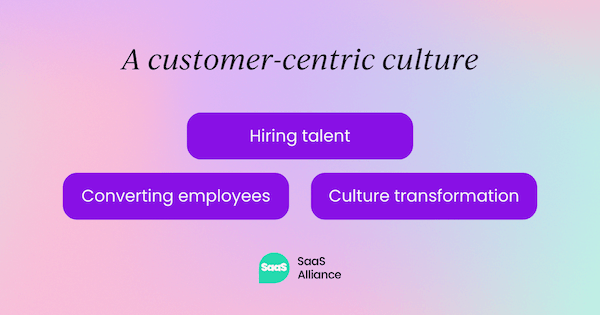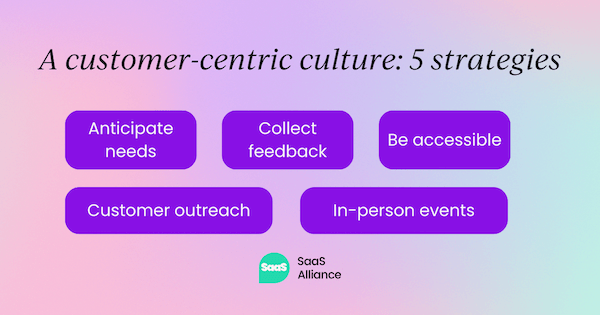For all SaaS leaders, the ultimate goal is long-term relationships with customers. But, like all long-term relationships, they’re built on a bedrock of trust.
You can only develop that trust through cultivating a customer-centric approach. That means every aspect of your organization is designed to foster a first-rate customer experience. Retaining customers is 5-20 times cheaper than acquiring a customer, and a customer-centric culture is a great way to launch an effective retention strategy.
Here, we zoom in on how to cultivate a culture that puts customers at the heart of your business. Here’s a breakdown of our agenda:
- What is a customer-centric culture?
- Why is customer-centric culture important
- How do you build a customer-centric culture?
- What are the three stages of a customer-centric culture?
- How do you create a customer-centric culture in 5 steps?
Before we dive into the nitty gritty, let’s do some basic customer-centricity 101.
What is a customer-centric culture?
It might seem obvious. After all, don’t all SaaS companies have a customer-centric culture?
Ideally yes.
But in reality so many SaaS companies are so focused on growth that they don’t necessarily prioritize the essential component that should be at the front of mind for all competitive organizations in an ultra-competitive landscape: providing an experience to delight and excite customers.
Customer-centric companies will aim to form long-term relationships with their customers, getting to know their pain points and challenges intimately and making it their mission to address them.
Why is a customer culture important to customers?
When it comes to SaaS, the power is really in the hands of the customer more than ever before.
And the pressure to please and convince customers to stick around is higher than ever. As a result, the onus is on SaaS companies to make their customers the stars of the show and give them an experience they can’t help but wax lyrical about.
In short, customer-centricity leads to greater chance of retention, which is an essential pillar of your customer acquisition strategy. The more loyal customers you have at your side, the better your company looks on the global stage, meaning you have a greater chance of attracting new customers. In current times, prospects rely heavily on existing customer reviews when making that all-important buying decision.
Guru Bhat, VP of customer success at Paypal, describes the importance of customer-centricity like this:
"Of course, one of the principal goals of any organization is to grow and expand, and they're always plenty of opportunities for things to go wrong. With so many different customers depending on us, all with varying levels of needs, there’s a lot of potential for misunderstanding and miscommunication.
For us, it all starts with being a customer-obsessed company. We have the privilege to serve millions of customers around the world, and we want to be worthy of that trust."
How do you build a customer-centric culture?
When it comes to the SaaS industry, there really is no one-size-fits-all approach.
How you choose to woo new customers is really going to depend on your demographics and what you uncover in your customer research.
For example, if your audience is more general and less tech-savvy, you may have to adopt a more hands-on approach to customer onboarding. Still, if you're selling products to developers, they tend to prefer a more self-guided onboarding approach.
Having said that, there are some general steps that pop up again and again with companies that manage to succeed. Before we delve into those, it’s important to stress that this process often requires a pretty dramatic cultural shift, and for that to happen, you’re going to need an all-hands-on-deck strategy.
What are the three stages of creating a customer-centric culture?
In general, there are three major stages to customer-centricity. But if you're a bit strapped for time, check out this infographic. 👇

Stage 1: Hiring for a customer-centric culture
It all starts with populating your org with folks with the right intentions.
You want ambitious people, sure, but if you get the impression that you’re interviewing someone who only stresses personal success or monetary gain, they might be a bad fit. Instead, look for someone who emphasizes the importance of customer satisfaction.
Put yourself in the shoes of the customer
When interviewing specifically for customer-focused employees, it can be helpful to imagine yourself as one of your customers, picture their needs and reasons for signing up for your product, and then ask questions with these needs in mind.
SaaS leaders should, of course, always consider the customer's interests in every process, but this really needs to come into focus during the interview stage so that this culture can be spread throughout the organization.

Hiring your champions
So once you’ve passed the stage of assessing whether the person can put the customer first, you want to look for someone who resonates with your company’s mission and values. The reason for this is that values trickle down from the top.
If the people you’re hiring in your senior positions don’t believe in your customer-centric vision, it’s highly unlikely that your more junior employees will be striving toward that mission. Hiring advocates leads to future advocates, whether that’s through future hiring or through referrals.
Stage 2: Creating a customer culture from within
Even as you go about hiring employees for your new customer-centric mission, you’re likely going to have existing employees who aren’t quite on board with it. It’s important to address this because, even if you’re hiring people with the right mindset, those existing employees can potentially have a negative impact on them.
This is when it’s essential to invest in company-wide training with customer-centricity at the forefront.
Much of this starts with little details, such as the way you choose to communicate with your employees. You might ask the question, for example: "When will that report be ready." What's wrong with this question? It lacks empathy. Try this instead:
"Is there anything I can do to help you with that report?"
Better yet, try:
"Is there anything our organization can do to make the report-writing process work better for you?"
With these kinds of questions, you’re asking employees for their considered feedback. These are open questions. According to Gallup:
"Those words can immediately create a trusting atmosphere in which feedback is exchanged and processed effectively. A feedback-rich environment drives business outcomes."Making your customer-centric culture synonymous with your brand
Think about the culture you want to spread to the world and consider replicating that from within.
In the day-to-day toil of achieving your growth, it’s easy to become cynical and allow the culture within your organization to be at odds with the face you show to the world. Many organizations operate this way, and it might seem fine, except the problem is that prospects are very good at sniffing at bulls**t a mile away.
They can tell if you don’t believe in the message that you’re trying to tell. It’s much easier to sell a product that you truly believe is going to help your customers. And this impression is going to radiate out in your pitches.
All hands on deck for a customer-centric culture
It can’t simply be a solo project. It has to be implemented in every aspect of your org. No initiative can ever run successfully unless it touches every area.
You’ll need to host meetings with the senior representatives of every department and gain an understanding of how this new initiative: a) is going to impact their department and b) how they’re going to be able to practice this mindset in their role. Employees are resistant to change when it seems as if you, as a leader, don’t have sympathy for how it will change their job or make it more difficult.
Stage 3: Making customer-centricity your culture
This is really the holy grail, where customer-centricity is no longer something you have to think about but something that your organization lives and breathes. It’s ingrained in every observation, plan, or action that your organization takes.
But what does it look like in companies that can accomplish this? We dive into that here.
Customer ambassadors
A great way to make customer-centricity an ingrained part of your org, is to appoint your own internal panel of customers. This ensures you’re always in touch with how your customers are feeling and how they’re going to respond to new strategies, or how the needs of your industry are changing and shifting.
Many SaaS companies seek to capture the customer's voice. This is important because the industry is always changing, so if you have major influencers and people who are keeping an ear to the ground in the SaaS landscape, you can stay ahead of the curve.
There is another major benefit in that ambassadors act as resounding endorsements for your org. Prospects are always going to be more receptive to endorsements from other customers, so when they see that some are so enamored with your brand that they’re willing to become ambassadors, it’s going to entice them to convert.

Strengthen internal relationships
You might think a culture of cynicism and mistrust isn’t visible to the outside world, but the fact is that happier employees lead to more cordial interactions with customers. When employees feel a sense of belonging, they feel a sense of pride in their org, which is apparent to the customers you’re talking to.
So, if you’re looking to foster empathetic relationships between employees and customers, think about creating empathy from within. Social events within your company might seem like a nice-to-have, but they’re an essential way of building rapport within your organization, ultimately leading to a stronger organization.
Empathy within leads to empathy without.
Now that we’ve gone over the essential tenets of a customer-centric culture, let’s dive into some more practical strategies for making customer-centricity a reality for your org.
How do you create a customer-centric culture in 5 steps?

1. Anticipate customer needs
In the current landscape, it simply isn’t enough to answer customer concerns as they come in.
You should be able to proactively address concerns before the customers even voice them. Much of this work is done before you even go to market. Ideally, you will have conducted thorough market research on the kind of customers you need to be targeting and what their concerns are going to be.
But once your org is up and running, it helps to have accurate customer profiles based on the data you’re collecting so you can accurately assess levels of customer engagement and satisfaction.
This way, if a customer seems to be in danger of churning, you can swoop in for the rescue before the customer considers churning. In short, it’s all about having an accurate idea of who your customers are and what they need.
2. Collect customer feedback
It sounds obvious, but your product is there to improve the lives of your customers. With this in mind, the only way you can really improve is by continuously collecting customer feedback. Customer needs are never going to stay the same, so you need to make customer feedback collecting a continuous process and an essential part of your business's day-to-day running.
There are many different ways you should go about this, including:
- Surveys
- Chat
- SMS
- Phone calls
- In-person meetups
- Message boards
Surveys
Surveys can be a superb way to gather honest feedback from your customers. Let’s dive into how exactly they can help here: 1. What do your customers really want?
Imagine you could just ask your customers what they're into and what they're not. Surveys do just that! You find out what features they love, what new stuff they’re craving, and how your service fits into their daily grind.
1. How happy are your customers?
It’s like checking the pulse of your customer base with something called NPS (Net Promoter Score) or CSAT (Customer Satisfaction Score). These metrics tell you how much your users are loving your service. Seeing these scores trend up or down can reveal what needs improving.
2. Can we make customer support even better?
Feedback on support can show you where the hiccups are and how to make your support team shine even brighter. Plus, it’s a chance to determine where a chatbot does the trick and where a human touch is needed.
4. User experience: smooth sailing or rough seas?
A survey can point out where users are getting stuck or frustrated. It's all about making their journey as smooth as butter.
Utilize user testing
A great way to test whether your in-development products are really made for your customers is to put them in their hands before you release them to the world. This can allow you to pivot and ensure that every aspect of your product is designed to delight your customers.
3. Reach out
Customers may not always have time to take the surveys you send out, and their responses may not always be as thorough as you might like. A call or a video chat can be a great way for customers to give you a holistic account of what they like about your product and what’s going wrong.
Additionally, customers will appreciate your org taking the time to reach out to them in person, which may help to boost their loyalty and improve your brand reputation as a whole.
4. Be accessible to your customers
Addressing customer concerns is time-consuming and costly. Many tech giants, for that reason, will purposely make it very difficult for customers to make contact with support.
Preferring customers to seek guidance through pages and bots is understandable, but in the long term, it doesn’t exactly sing: ‘We put the customer at the heart of our organization.’
Making your contact details easily visible does wonders for your brand on the global stage, and you’ll definitely see a long-term payoff. Just being there and being available is a great way to build strong customer relationships.

5. In-person events
All SaaS companies should seek to cultivate that human touch, that feeling that you're not just a faceless corporation but a company made up of people who actually care.
Although this is possible through video conferencing technology, there really is no substitute for in-person meet-ups. That way, you can actually connect with your customers on a human level, get to know what really makes them tick, and form the bonds that lead to customer loyalty. Additionally, it can be a great way for you to spotlight your customers and their achievements.
Now we may seem like we’re contradicting ourselves. After all, we just stressed the importance of in-person customer support, but technology can really help you to solve the more fundamental, easy-to-solve customer concerns so that your human personnel can tackle the more tricky problems.
For example, basic questions, such as ‘how do I find this?’ can be solved quite efficiently and quickly by chatbots. Your customer support teams can only operate effectively when they aren’t overwhelmed, and technology can be a great way to filter out problems that don’t need human expertise.
Wrapping up
Companies looking to retain and convert customers should look to bridge the gap between their org and customers. That is the primary goal of customer-centricity: to create a clear path where feedback can pass back and forth between customer and organization.
Let’s put customer-centricity at the heart of SaaS and enjoy the endless benefits of customer retention and continuous conversion.
Like what you see? Why not check out exclusive insights from some of the leading minds in SaaS?



